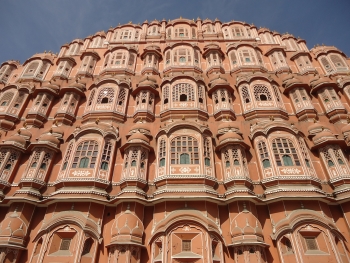Jaipur City, Rajasthan

Jaipur City, Rajasthan, is a planned city combining ancient Hindu, Mughal and contemporary Western ideas.
It was designed in 1727 by Raja Jai Singh to fit a commercial city with space for markets and crafts. It has a rigid grid plan and uniform street facades. Iconic monuments include the Govind Dev temple, City Palace, Jantar Mantar and Hawa Mahal.
Community Perspective: With two other WHS within reaching distance (Jantar Mantar, Amber Fort) this is an obligatory stop. Most reviewers found the ‘Pink City’ in dire need of restoration. The City Palace and the Water Palace are recommended for a visit, as well as the iconic façade of the Hawa Mahal.

Map of Jaipur City, Rajasthan
Community Reviews
Clyde

I visited this WHS in January 2012. It's a great base to visit the Jantar Mantar WHS and the inscribed Amber Fort which is only 11km away from Jaipur. Other nearby forts worth visiting with the one in Amer are the Jaigarh Fort and the Nahargarh Fort.
The pink city was in dire need of restoration when I visited and pretty much everything except the Palace of the Winds/Hawa Mahal facade (photo) was crumbling although the structures are not that old! Jaipur is one of those places on the WH list which unjustifiably have separate WHS for specific buildings and as a historic centre/city but in my opinion it would make much more sense as 1 worthy WHS rather than having 2 which in such a case seems counterproductive.
The Jaipur city palace is worth visiting if only for a good view of Diwan-e-Khas, Peacock gate and the entrance gate of Rajendra Pol. If you were to visit only one museum here, make sure to visit the Albert Hall Museum also known as the Government Central Museum, which is Rajasthan's oldest museum and a fine example of Indo-Saracenic architecture. The main highlight inside apart from the architecture, believe it or not, is a far-from-home Egyptian mummy!
Another highlight was the Water Palace or Jal Mahal in the middle of the Man Sagar Lake. The palace and the lake around it were renovated and enlarged in the 18th century by Maharaja Jai Singh II of Amber. When I visited the lake was full but apparently during the summer months the lake dries out! An old yet very interesting BBC documentary named Around the World in 80 Gardens (Episode 3) explains the palace's importance for water management and the unique features of Mughal gardens.
Nan

Most "cities" in India don't really have historic structures or buildings but are a sprawl of concrete buildings. And dirt and trash for that matter. Trust me: If you haven't been, you cannot imagine.
Jaipur is different in the sense that it really has a consistent historic core. You can take a walk through the town center and do site seeing. The city center is called Pink City due to the color of the houses. Pink is the color of hospitality in Jaipur and the city was painted in it in preparation for a visit by the Prince of Wales in 1876.
Jaipur itself is not that old. It was founded the 18th century when the Maharadscha moved his capital there. This explains a bit the consistency of the city center which was developed by an Indian architect, Vidyadhar Bhattacharya.
Apart from the Jantar Mantar, the Palace of the Wind (Hawa Mahal) is probably the most known building of Jaipur. While it does look pretty on photos it did not impress me much on entry. The state of preservation wasn't good. As was the case for most of the old town.
[Update July 2019] Looking at Jaipur as a consistent example of 18th-century Indian town planning and architecture, that is still fairly consistent, there is little doubt in my mind, that this deserved to be inscribed. With the Jantar Mantar already on the list, however, it begs to question why not go for a simple extension? Jaipur including the Jantar Mantar and potentially the Amer Fort would have been world class as one site. Each site individually is great.
In addition, the state of preservation was poor in 2013 and some renovations would be in order. The WHC seems to have said the same.
Getting There
I flew in from Bangalore and left by train to Agra. The trains to Agra are fast. If the train schedules work out, you may even try either as a day trip. Delhi can be done by car. Apparently many tourists do this as a combined trip called Golden Triangle.
While You Are There
Nearby Amer has on of the Hill Forts of Rajasthan. If you visit Jaipur, visiting Amer is a must. There are several additional (not WHS) forts in the area.
Els Slots

The Walled City of Jaipur has (after some debate) received WH status this year. The city in Northern India already has 2 WHS within its borders: Jantar Mantar and Amer Fort (the latter as part of the Hill Forts of Rajasthan). The city authorities however still seemed to have longed for the recognition of its historic center in general. The core zone of the proposed WHS will be limited to the area within the old city walls – this leads to an exact location inscribed twice connection for Jantar Mantar, but not for Amer Fort which lies in a separate village within the municipality some 11km away.
I visited Jaipur in 1993, arriving by Pink City Express train from Delhi. The city was part of a whirlwind group tour across Northern India and Nepal and I think we stayed for 1 night only. My photo album of the trip shows that we covered the City Palace, Nahargarh Fort, the observatory, Amer Fort and a cinema. It would have been hard to have not seen the Hawa Mahal (the Pink Palace) as well, but I have no photos of this landmark left.
The Nahargarh Fort and cinema lie just outside of the walled city. This leaves the City Palace (dating from 1732) for me to describe. This was the seat of the Maharaja of Jaipur and thus a core element of the 18th century planned city that is to sustain the Outstanding Universal Value of the nominated site. It is a large complex, with several richly decorated gateways, palaces, pavilions and temples. Gardens and an artificial lake complete the scene.
My memory in general is terrible, so don’t ask me about specific observations about Jaipur from 26 years ago. A short glimpse has remained though: we went to see a Bollywood movie in The Raj Mandir, a “meringue-shaped auditorium … and … a popular symbol of Jaipur”. The movie we saw coincidentally included fragments filmed in the Netherlands: there were shots of scarcely clad women and of violence on the train, with people having their heads jammed between the windows. Maybe this portrayed image explains the weird attitude some Indian men display towards European women….
Community Rating
- : Martina Rúčková Chole Ross Craig Harder Vernon Prieto George Evangelou Ge zhang Koen Vliegenthart Jezza Travelure Priyaranjan Mohapatra Amitlchoudhuryjbp Yamen Roxfts Laurine Lembu
- : Aspasia Juropa Kokoro Fede1203
- : Joyce van Soest Patphilly Jeffrey Chai Ran Carlos Garrido Tamara Ratz Alexander Lehmann Philipp Leu Dutchnick Akacesfan Adiaro18 J_neveryes Javier
- : Solivagant Frederik Dawson Philipp Peterer Szucs Tamas Wojciech Fedoruk Clyde Chalamphol Therakul Xiquinho Silva Daniel Gabi Riccardo Quaranta Kevin McFarland Carlo Sarion Alex Marcean Tarquinio_Superbo Akhilpreeti GerhardM
- : Els Slots Tony H. Nan Randi Thomsen Svein Elias Alexander Parsons Zoë Sheng Sachin David Marton Jean Lecaillon Tevity Lucio Gorla CalvinLoh Jakubmarin Richard Stone MoPython Alikander99 Wieland Kelseyyurek Jon Opol BMuramatsu
- : Bernard Joseph Esposo Guerrero Lukasz Palczewski Ralf Regele Luke LOU Shandos Cleaver Ammon Watkins HaraldOest Travtasy Adrian Turtschi Gordon Mitchell
- : Clem C
- : Christravelblog
Site Info
Site History
2019 Advisory Body overruled
ICOMOS advised Deferral, WHC went for Inscribe after Brazil amendment (14:5 over Referral)
2019 Inscribed
Site Links
Unesco Website
Official Website
Connections
The site has 11 connections
Art and Architecture
Constructions
History
Human Activity
Individual People
Timeline
Trivia
WHS Names
World Heritage Process
Visitors
339 Community Members have visited.
The Plaque
No plaque has been identified yet for this site.